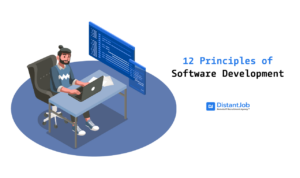One of the most common misconceptions about the software development cycle is that it ends after deployment. However, another important phase after deployment takes place: the maintenance stage. Software maintenance happens after the active development stage to further refine the features of the product.
A software needs periodic refreshes to ensure it runs smoothly and preventive maintenance to reduce the possibility of a problem occurring. Software maintenance is important as it modifies and continuously updates software applications. The process is useful in eliminating malfunctions and all possible errors to improve work efficiency and system performance.
The following piece covers the meaning of software maintenance, its importance, types, and how to achieve effective software maintenance.
Let’s dive in.
Table of contents
What’s Software Maintenance?
Software maintenance involves updating or modifying software to keep up with customer needs. It ensures your software is excellent in terms of policies, technology, and experience.
A lot of things are needed for maintenance to succeed. Just like the active software development stages, there are also tools needed to efficiently carry out software maintenance. One example of these tools are maintenance software that are specifically designed to evaluate another program.
It takes 1 to 2 years to build an effective software system. However, maintenance and modification are ongoing processes that may take 15 to 20 years. Of course, it depends on how long you want your software to last before retiring.
It also entails the optimization of software performance and applying advanced development to reduce errors in the software. Use software testing tools to ensure your product is functioning appropriately.
Importance of Software Maintenance
Why is software maintenance important? These are the main reasons:
1. Fix Bugs
Bugs hinder the correct functionality of the software. They could be associated with any part of the software, including the operating system and the hardware.
Software maintenance helps in identifying and resolving bug issues. It identifies the root causes for it to be addressed accordingly. And it ensures there’s better performance and all the parts of the software are functioning appropriately.
2. Improves Performance
A default within a software interferes with the software. Thus, conducting maintenance would resolve the detected issues. You could always conduct software testing to gauge the performance of your software.
The testing could be manual or automated. If you are a beginner, you can learn automation testing through many channels. There are various tutorials available online and it will be a great foundation for all beginners transitioning from manual to automated testing. It will also guide you in the right direction if you want to pursue a career in automated testing.
3. Enhance Software Capability
Software system maintenance entails making improvements to fit different market environments. It accommodates various programs. Here, different system features and telecommunication can be integrated.
It increases compliance, software work patterns, and hardware upgrades.
4. Removes Outdated Functions
Unwanted functionalities don’t serve any purpose in software. Instead, they occupy space, and affect its efficiency. You can use software maintenance like coding elements and UI to remove outdated functionalities.
Software maintenance enables you to replace outdated functions with new technologies and the latest tools. This allows the software to cope up with changing circumstances.
Types of Software Maintenance
There are four main categories of software maintenance:
1. Corrective Maintenance
Corrective maintenance majorly focuses on rectifying any bugs identified in the system to improve the software system. It involves conducting minor updates frequently.
2. Adaptive Maintenance
Adaptive maintenance deals with modifying and updating a client’s needs. This happens when a client needs a product to run on their new operating systems or new platforms. You can also do it when you want a product to interface with new software or hardware.
3. Preventive Maintenance
Preventive maintenance involves modifications and updates to prevent any future problems that software might face. Usually, it tends to be the issues that are not important but may cause problems in the future.
4. Perfective Maintenance
Perfective software maintenance is geared towards supporting the experience of the users. It supports new features that users want or change to different types of functionality depending on users’ demands. Perfective maintenance includes altering the current software functionality. It does this by removing, improving, or inserting new features and functions to care for your software effectively to take care of your software effectively.
Ways to Improve Software Maintenance
Software is a model of the real world. Thus, when the real world changes, it requires alteration whenever possible. The following are some of the ways to achieve effective software maintenance.

Always Listen to Your Help Desk
The help desk is an essential asset of your software maintenance. They usually receive all the complaints and the problems that users face. They get to know which apps or parts of an app are most problematic and why.
Listening to the help desk enables you to get insights, brainstorm, and do performance evaluations. Identifying persistent application failures allows you to address them. You can locate hotspots problems and ensure that the mistake isn’t repeated twice by the software developers.
Invest in Quality Assurance
Before a software goes live, it undergoes different stages of testing. The testing is done to avoid a week of problem reports, troubleshooting, and workarounds. End-to-end testing and UI testing are necessary for usability, technical correctness, and integration.
Testing to ensure you produce a quality product is an integral part of the software development process. Every time you reorganize your operations, always check on the quality of your code. Have QA in every stage of the development. This includes the planning, design, development, and testing.
Quality assurance reduces post-production software maintenance.
Automate Your Software Maintenance Process
A product is never fully completed after the development process. Every once in a while, you have to handle situations that you hadn’t envisioned before. Thus, it’s essential to stay flexible to manage any risks that may arise.
Automate anything around the maintenance process that you can. Examples are code reviews and production monitoring. This would save you time and maintenance costs, thus adding value to your business.
Automation leads to high productivity and also higher profitability. Your team will be better equipped for changes and won’t have to focus on areas that needed updates a month ago.
It enables you to respond to the changing marketing needs without having to increase the workforce.
Migrate Your Solutions to the Cloud
Migrating your software to Cloud would cut you from constant maintenance. It comes with tons of benefits like scalability, reliability, and security. Before the migration, ensure the cloud version is supported by the vendor.
One major disadvantage about this is you wouldn’t be sure whether the fixes you want will be accomplished. Nonetheless, if you can live with this inconvenience, why not.
Get Rid of the Applications that Don’t Add Value
Having a legacy system that doesn’t add value to your organization is common. However, you should consider ripping and replacing the old system with a new system. ‘Rip and replace’ works best if you have to integrate the system with other running software.
You can shift your system maintenance for a new system to a supporting vendor.
Use a Standardized Procedure When Installing New Software Releases
All fixes, additions, security patches, and installation of the new software release should be standardized. They should be consistent in all devices that the software runs on. Standardization smoothens the software maintenance processes.
Also, it relieves the pressure from the maintenance teams and the help desk. This happens each time the software releases aren’t systematically distributed. Or when the different devices are controlling other releases of the software.
Wrapping up
Software maintenance is necessary for your software to be effective. It solves several issues in the software that hinders it from performing its best. Updating your product helps save costs and reduce the software maintenance process. Lastly, effective software maintenance ensures your product is effective and maintains its quality in the long run.
If you’re looking to hire remote software developers, contact us! At DistantJob we can help you hire technical experts ready to start working for you in less than two weeks.



